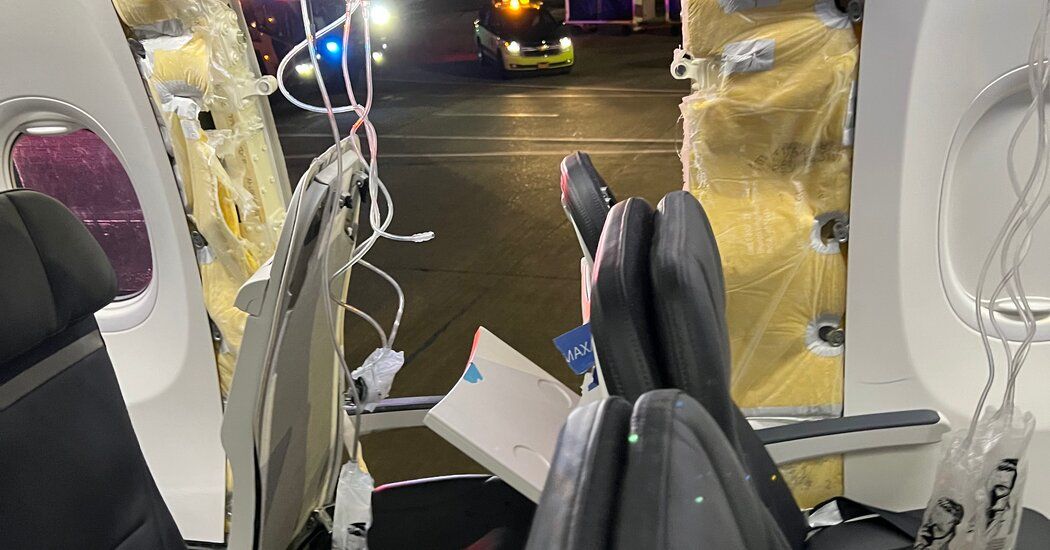The Federal Aviation Administration on Saturday ordered U.S. airlines to stop using some Boeing 737 Max 9 planes until they were inspected, less than a day after one of those planes lost a piece of its body in the air, terrifying passengers until the plane landed safely.
Alaska and United Airlines on Saturday began canceling dozens of flights after grounding their Max 9 fleets so the planes could undergo federally required inspections.
Alaska Airlines Flight 1282 took off from Portland, Oregon, on Friday bound for Ontario, California, but was diverted back to Portland six minutes later, according to FlightAware, a flight tracking website. Those on board the flight described a disconcerting experience, with the wind blowing through a huge hole that showed the night sky and city lights below. The plane landed about 20 minutes after taking off and no one on board was seriously injured.
One passenger, Vi Nguyen of Portland, said she woke up to a loud sound during the flight. “I open my eyes and the first thing I see is the oxygen mask right in front of me,” said Nguyen, 22. “And I look to the left and the wall on the side of the plane is gone.”
“The first thing I thought was: ‘I’m going to die,’” he added.
The National Transportation Safety Board sent a team to Portland to begin its investigation into the incident.
While the FAA has not yet publicly discussed the cause of the incident, it ordered airlines to inspect what it called a “center cabin door plug.” Some of the Boeing 737 Max 9s are configured with fewer seats and therefore do not need all the exits originally designed for the aircraft. Unnecessary doors are filled with a plug. The Alaska Air plane had two of those unnecessary doors, located between the rear of the plane and the wing emergency exits, that were “plugged.”
Forrest Gossett, a spokesman for Spirit AeroSystems, said Saturday that his company installed plugs in the doors of the Max 9s and that Spirit had installed the plug on the Alaska Air flight.
The FAA order affects about 171 aircraft. The agency said the required inspections should take four to eight hours per plane to complete.
“Safety will continue to drive our decision-making,” agency Administrator Mike Whitaker said in a statement. The FAA is working with the NTSB
Boeing issued a statement shortly after the FAA’s grounding order. “Safety is our top priority and we deeply regret the impact this event has had on our customers and their passengers,” Boeing spokeswoman Jessica Kowal said in the statement. “We agree with and fully support the FAA’s decision to require immediate inspections of 737-9 airplanes with the same configuration as the affected airplane.”
Alaska Airlines confirmed in a statement Saturday afternoon that it had begun inspecting door plugs and had cleared 18 of its 65 Max 9s to return to service. The airline said it expected to complete inspections in the coming days. As of noon Saturday, the airline had canceled about 100 flights, or 13 percent of those scheduled for the day, according to FlightAware. Dozens more flights were delayed.
United Airlines operates more Max 9s than any other airline, according to Cirium, an aviation data provider. Of United’s 79 Max 9s in service, 33 have already been inspected, the airline said in a statement Saturday. The airline said the removal of the planes from service was expected to lead to about 60 cancellations during the day.
“We are working directly with affected customers to find them alternative travel options,” the airline said in a statement.
Dave Spero, president of Professional Aviation Safety Specialists, a union that represents more than 11,000 federal aviation workers, including safety inspectors, said Saturday that his union’s aviation safety experts would be on the ground and the NTSB It would help them determine how the plug will be connected. covering the unnecessary door flew off the plane.
“From our perspective, there is no kind of acceptable situation where this kind of thing should happen; this kind of risk should not be introduced,” Spero said. “They need to find out how it happened and make sure it doesn’t happen again.”
The plane was just certified in November, according to the FAA aircraft registry. It entered commercial service that month and has since logged 145 flights, according to Flightradar24, another flight tracking site.
Keith Tonkin, managing director of Aviation Projects, an aviation consulting firm in Brisbane, Australia, said an excessive difference in air pressure inside versus outside the cabin could have caused the part to break.
“The passengers were probably able to breathe normally even when the plane was at its maximum altitude,” Tonkin added.
Nguyen’s friend, Elizabeth Le, 20, said she heard “an extremely loud bang.” When she looked up, she saw a large hole in the wall of the plane about two or three rows away, she said.
Ms. Le told that there was no one sitting in the window seat next to the hole in the wall, but that a teenager and his mother were sitting in the middle and aisle seats. Flight attendants helped them to the other side of the plane a few minutes later, she said. The boy appeared to have lost his shirt and his skin appeared red and irritated, she added.
“It was honestly horrible,” he said. “I almost broke down, but I realized I needed to stay calm.”
There were announcements over the public address system, but none were audible because the wind hitting the plane was so strong, he said.
Evan Smith, 72, a lawyer who was returning to his home in Murrieta, California, after visiting his daughter and son-in-law who live in Portland, said he heard a loud “bang” and saw some “dark, full stuff.” of smoke”. ” circling the cabin.
Mr. Smith said his experience as a military police officer taught him that it is important to keep a cool head in these situations. Furthermore, he said: “The plane was stable. I wasn’t shaking. He wasn’t doing any strange maneuvers. “It was just flying stable.”
And he added: “I was sure that the plane was fine and that we were going to descend safely.”
Passengers flooded Alaska Airlines’ phone lines Saturday to rebook canceled flights and determine whether upcoming flights would be affected by the suspension. Customer service wait times, passengers said on social media, exceeded seven hours.
Sara Nelson, president of the Association of Flight Attendants, a union representing flight attendants at Alaska, United and other airlines, said in a statement Saturday that she welcomed the inspections required by the FAA.
“This is a fundamental measure to ensure the safety of all crew and passengers, as well as confidence in aviation security,” he said. “Life should always come first.”
The Air Line Pilots Association, a union representing pilots at Alaska, United and other airlines, echoed that sentiment in a statement Saturday, saying it applauded the FAA for ordering the grounding to ensure the safety of the crews and the flying public.
Boeing’s Max planes have a troubled history. After two Max 8 plane crashes killed hundreds of people within several months in 2018 and 2019, the Max was grounded around the world.
In 2018, Lion Air Flight 610, a 737 Max 8, crashed into the ocean off the coast of Indonesia, killing all 189 passengers and crew members. Less than five months later, in 2019, Ethiopian Airlines Flight 302 crashed shortly after takeoff from Ethiopia’s capital, Addis Ababa, killing all 157 people on board.
The Max planes were grounded after the second crash. Boeing made changes to the plane, including the flight control system behind the crashes, and the FAA cleared it to fly again in late 2020. In 2021, the company agreed to a $2.5 billion settlement with the Department of Justice. , resolving a criminal charge that Boeing conspired to defraud the agency.
In December, Boeing urged airlines to inspect all 737 Max planes for a possible loose bolt in the rudder control system after an international airline discovered a bolt with a missing nut during routine maintenance. Alaska Airlines said at the time that it expected to complete inspections of its fleet in the first half of January.
Max aircraft are widely used. Of the nearly 2.9 million flights scheduled globally in January, 4.3 percent will be flown with Max 8 aircraft, while 0.7 percent will use the Max 9.
The Max is the most popular plane in Boeing history, accounting for one-fifth of all orders placed since 1955, according to company data.
Juan Yoon, Victoria Kim, Orlando Mayorquin, Rebeca Carballo and Cristina Chung contributed with reports.








